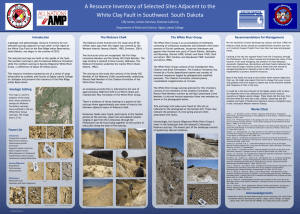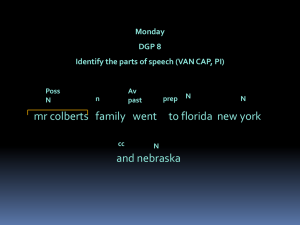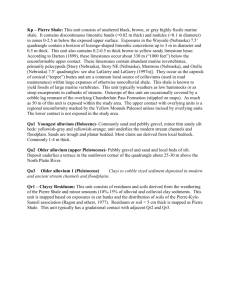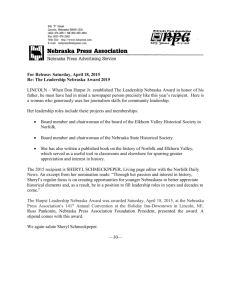Article Title: Sea Monsters and Dinosaurs
advertisement
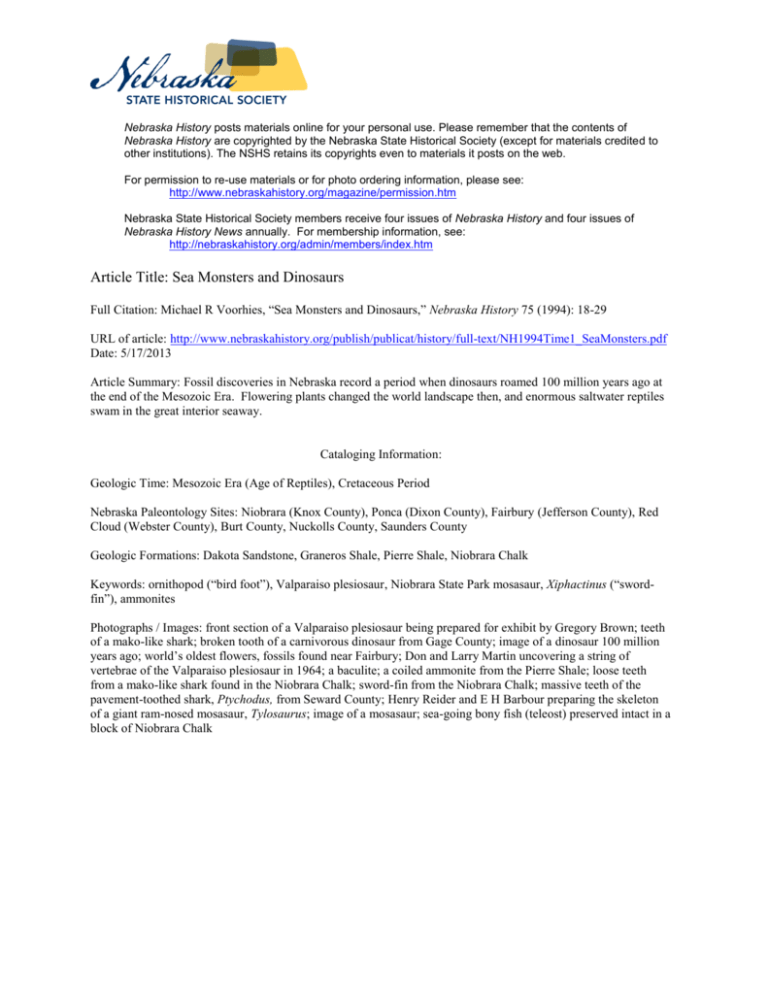
Nebraska History posts materials online for your personal use. Please remember that the contents of Nebraska History are copyrighted by the Nebraska State Historical Society (except for materials credited to other institutions). The NSHS retains its copyrights even to materials it posts on the web. For permission to re-use materials or for photo ordering information, please see: http://www.nebraskahistory.org/magazine/permission.htm Nebraska State Historical Society members receive four issues of Nebraska History and four issues of Nebraska History News annually. For membership information, see: http://nebraskahistory.org/admin/members/index.htm Article Title: Sea Monsters and Dinosaurs Full Citation: Michael R Voorhies, “Sea Monsters and Dinosaurs,” Nebraska History 75 (1994): 18-29 URL of article: http://www.nebraskahistory.org/publish/publicat/history/full-text/NH1994Time1_SeaMonsters.pdf Date: 5/17/2013 Article Summary: Fossil discoveries in Nebraska record a period when dinosaurs roamed 100 million years ago at the end of the Mesozoic Era. Flowering plants changed the world landscape then, and enormous saltwater reptiles swam in the great interior seaway. Cataloging Information: Geologic Time: Mesozoic Era (Age of Reptiles), Cretaceous Period Nebraska Paleontology Sites: Niobrara (Knox County), Ponca (Dixon County), Fairbury (Jefferson County), Red Cloud (Webster County), Burt County, Nuckolls County, Saunders County Geologic Formations: Dakota Sandstone, Graneros Shale, Pierre Shale, Niobrara Chalk Keywords: ornithopod (“bird foot”), Valparaiso plesiosaur, Niobrara State Park mosasaur, Xiphactinus (“swordfin”), ammonites Photographs / Images: front section of a Valparaiso plesiosaur being prepared for exhibit by Gregory Brown; teeth of a mako-like shark; broken tooth of a carnivorous dinosaur from Gage County; image of a dinosaur 100 million years ago; world’s oldest flowers, fossils found near Fairbury; Don and Larry Martin uncovering a string of vertebrae of the Valparaiso plesiosaur in 1964; a baculite; a coiled ammonite from the Pierre Shale; loose teeth from a mako-like shark found in the Niobrara Chalk; sword-fin from the Niobrara Chalk; massive teeth of the pavement-toothed shark, Ptychodus, from Seward County; Henry Reider and E H Barbour preparing the skeleton of a giant ram-nosed mosasaur, Tylosaurus; image of a mosasaur; sea-going bony fish (teleost) preserved intact in a block of Niobrara Chalk The Valparaiso plesiosaur, the longest neck in the ocean. The front section of a 90-million-year-old marine reptile being prepared for exhibit by Chief Preparator Gregory Brown of the University of Nebraska State Museum. 18 CHAPTER TWO Sea Monsters and Dinosaurs The First Flowers and the Deep Blue Sea Teeth of a mako-like shark By Michael R. Voorhies University of Nebraska State Museum FOLLOWING THE LAST RHYTHMIC ADVANCE and retreat of the Per­ mian sea 270 million years ago, the Midwest remained high and dry until the next layers of sediment began to accumulate about 170 million years later. By then the Age of Reptiles, or Mesozoic Era, was well under wilY. Nebraska rocks record the last 30 million years of the Age of Reptiles .in considerable detail, but the record of the first 150 million years of that period is missing. Stretching from Niobrara and Ponca on the north to Fairbury and Red Cloud on the south are geologic formations containing fossils typical of the last half of the Cretaceous period, a time when the last of the dinosaurs ruled the continents, when flowering plants permanently changed the world landscape and when enormous saltwater reptiles swam above the chalky bottom of the great interior seaway. Fossil discoveries in Nebraska shed light on all those momentous events. Cretaceous Sandstone, Shale and Chalk From oldest to youngest, the Cretaceous formations highlighted in Nebraska are the Dakota Sandstone, the Graneros Shale, the Niobrara Chalk and the Pierre Shale. As you might guess from the names, most of those geologic units , which can be traced throughout much of the American West, were first described and studied by early explorers of the Missouri River. The Dakota Sandstone consists of mostly rust-colored layers of sandstone and clay. If you drive the interstate between Lincoln and Omaha you can get a good look at the Dakota in roadcuts about halfway between the two cities. The formation was deposited along the eastern edge of a shallow sea that extended 19 from the Gulf of Mexico to the Canadian Arctic. Streams swollen by heavy seasonal rains carried sediment westward toward the sea, gradually building up a vast blanket of sand in levees, channels and estuaries. Beds of clay produced by deep, tropical weathering accumulated in abandoned stream channels and in tidal marshes bordering the sea. Leaves, branches and other plant debris sometimes accumulated in sufficient thickness to form beds of lignite (low­ grade coal). The Dakota has long been famous for fossil plants, but its most significant paleobotanical secrets have been discovered only recently. Where are our Dinosaurs? The broken tooth of a carnivorous dinosaur from Gage County, compared with teeth of a smaller meat-eater, Allosaurus, from Utah, is one of only two known dinosaur fossils found in Nebraska. Nebraska's only known dinosaurs lived 100 million years ago in a coastal forest. The Dakota Formation in southeastern Nebraska contains the oldest evidence of flowers taking over from more pl'imitive plants during the Cretaceous period. 20 Unfortunately, the acid soils of the tropical forests on the Dakota coastal plain seem to have caused bones to disintegrate. To date, fragmentary remains of only two dinosaurs have been found in Nebraska, both in the Dakota, our state's most likely source for those ever-popular fossils. The honor of discover­ ing the first one goes to J.B. White of Decatur who found the lower end of a huge thigh bone on his farm in northeastern Burt County near the Missouri River in 1928. He hauled the 65-pound fossil to Lincoln and donated it to the museum at his alma mater, the University of Nebraska. All experts who have studied the bone agree that it is an ornithopod ("bird foot") a plant-eating dinosaur that walked on its hind legs. Canadian dinosaurologist Dale Russell has given the descriptive nickname "cow lizards" to those massive vegetarians. A more specific identification is difficult to make because of the specimen is incomplete and because dinosaurs of that age (about 95 million years) are not well known. Some specialists see a resemblance to iguanodonts (cow lizards with thumb spikes, best known from Europe) while others suspect affinities with hadrosaurs (duckbills) which are extremely common in much later Cretaceous rocks deposited on the western side of the interior seaway. Whatever else it was, the BUlt County dinosaur was big; the thigh bone matches even the largest elephants (mammoths) in size. Bearing in mind that the creature can"ied nearly all its weight on the hind legs we can conservatively estimate a live weight of five tons for the animal. '. ,~ .;'J'j~"}' ) , '/THE ~IRST FLOWERS ."',. ';;!/"i~:.t:.,;y. '-'.~ -". I, I ~r~ar~t;R. Bol.ic.!<.; Curatqr of Botany, University of Nebraska State Museum • , , '" 'Y. ' , /'" f~ _./ "" .'" ". Neb~aska;§ georogical nic-ord inclydes ,"" V /! . ", r '... relJlarkaoltJ pla.jfffossils that .1l!lpw,·. us)to~ pic. '~ ·r) ) . ". ' ture-·th:e \}each pl~ts a,.Cretll~ep us " pleslOs~ur " inightha'v ~,spied~.wl')~~~i,t~,~?rii.£netK poked Qut of,ihe ;vatei:f~q?:.viS.i~lyz~'a rTidrt\IJl,?th tro~piog trJ0ugh a9' p'eti;; s~rli<;e par~r~~d in south-' central Nebra.~~l! WlTel/ :Omaha was covered, by glaciaL·ice . ,':' p~, . ,~. ~Yi/'; , " Oneo'(the m'0~t s~ecta6ulaf eNents·iiJ, plant evolJiion'.r.is recptrd~d i~ the ';QcksJ bf/ the " "I . f~ , . D~kota FOlTllati'6n'exposetl on a diago13al (rom _'Dakota (ounty sOllJhwest, \0 l.effersoJl Coun.ty. -Before II1?0ut i 00 niilli6n y.ear~,~g~ most o f .·the w orld :s pj ants w.~ re fern§ ; palm-like cycads oi. t;\f\~i-gr~6.b : ' f/ " ', '-;f:!/." " I ,. • ~ "' , ­ mode~n 'rose family, the connection is as j f • .I . . ' '" tenuous as the I OO-mlllIon-year !Ime gap sugg~S!s. Several types of leaves o.c cur w'itn' the ' flowers and pl'obably represent djstant a lces­ 'tors, of the bay, magnolia and;'rose' farriili~s. ' . . /~ Y;about 34 million years ,ag?, w~stem Neljraska was covered by a nch,-,moderately wet forest containing cousins of black walnut, wild cheITY, Kentucky coffee and elm trees . As ,the climate began to change, grasses and !. . su~.lJowers began (0 replace the trees . . The climatic low point (in both tempera­ ture and livability) was reached during.the Ice Age. To investigate this period scientists,often , I ' .1 ~ conifers. :-1:h.t· I?;!,~.9~. ,t F,ormatiqn roc,ks- hold _ . theworJd 's "e'[rliesl . evidence" tha( flowers . were taking over ,from those more '. Plj miti ve plants : The !~ffers6n • Coumy rocks th~l- were once the sand and mud adjacent · to an inland sea contain .the oldest complete fos sil flowers found anywhere in the world. At a glance, the fos­ sils look a little like rose, apple or peach flowers, but a carefu' inspection shows ' that while they may be very distant relatives of the " • study the fossil ized outer wall of pollen grains, the microscopic spheres that '-plants use to ..,.. 'tr,ansport their sp.erm. , Recently, ,vertebrate paleontologist Mike Voorliies, scJ-aped . t~e s.inus· .c avities of 500,000-year-old m~mmoth and mastodon skulls from Nu~kol(s County and gave the material to me 'for analysis. To our delight, boih samples not only had pollen, they had differempfoportions of pollen types. r Pollen from . the mammoth skull, which came fromthe bottom p(the .quaITY, was most­ ly spruce mixed with po llen of other plants that usually grow where it is colder and wetter / than Nuckolls County is, today. The _pollen frum the mastodon skull, recovered above the mammoth bones, was"mostly elm mixed with tree and prairie herb pollen, types that indicate temperatures more like today's. Together the plant and anill)al fossils give Us a glimpse of Ne­ braska at the time when an early Pleis­ tocene ice sheet began its retreat. and an open spruce and conifer forest was replaced by prairie-like vegetation with elm trees growing near the water sources. 's oldest flowers are fossils found near Fairbury in Jefferson County. . ~­ --:.-.1" " The next Nebraska dinosaur discovered was not so large but is especially interesting because it is a meat-eater. Eight-year-old Aaron Thornburg found a saw-edged petrified tooth in the road gravel near his home in Lewiston in 1981. Teeth of Ice Age mammals are fairly common in gravel, but this one looked different enough to Aaron's mother, Doris, that she sent it to the univer­ sity for identification. It turned out to be a partial tooth of a large carnivorous dinosaur about halfway in size between a 1.5-ton Allosaurus and a five-ton Tyrannosaurus. When we searched the quarry in Gage County where the load of gravel came from we found many chunks of Dakota Sandstone from which Aaron's tooth might have come, but no more dinosaur fossils. Let's hope we don't have to wait another 50 years before the next Nebraska dinosaur shows up. Even though they are likely to be incomplete, Dakota dinosaurs are especially interesting because they lived on the eastern side of the seaway that cut North America in half during the Cretaceous. A reasonably good skeleton of a new species of an armored dinosaur (the only one of its kind in the world) has been found in the Dakota of eastern Kansas, and some 21 eastern Nebraska explorer might find something comparable in our own "rusty rock." It would be nice to know exactly what kinds of dinosaurs were eating the flowers, plants which first appear in the Dakota Formation. F'rom a shale bank on North Oak Creek, Don (left) and Larry Martin uncover a string of vertebrae of the Valparaiso plesiosaur in 1964. The Martins and other museum workers joined volunteers from the Lincoln Gem and Mineral Club in excavating this fossil treasure. 22 The Sea Returns If Nebraska's dinosaurs are somewhat disappointing, the same cannot be said for their seafaring relatives, some superb examples of which have been found in the state. Among dozens of significant discoveries we will highlight two: the Valparaiso plesiosaur and the Niobrara State Park mosasaur. Ask grade-schoolers what the Loch Ness monster looks like and they might draw a picture of a plesiosaur long, snaky neck arching up from a short, flat body with big paddles. Paleontologists tend to dismiss the Loch Ness story as a hoax, but we know that plesiosaurs were real. Their bizarre skeletons have been found in Jurassic and Cretaceous marine deposits around the world, and some species were the largest of all seagoing reptiles, rivaling all but the biggest dinosaurs in size. There are two basic varieties: long necked ones with small heads and short necked ones with big heads. Remains of both kinds have been found in Nebraska. All plesiosaurs had flat, wide, flipper-like front and hind legs that extend straight out from the body. Early attempts at restoring plesiosaurs show them using their limbs as oars, literally rowing themselves along at the surface of the water, but newer studies by British paleontologist Jane Robinson and others have shown that they actually "flew" underwater like penguins or sea lions do, moving the flippers mostly up and down rather than from front to back. To decide how plesiosaurs (or any other extinct animal, for that matter) moved, we look at their anatomy and make comparisons with living animals we can observe "in the flesh." Even though we have only the bones of plesiosaurs, those bones have markings showing where the muscles attached and how big they were, so it is possible to a pretty good idea of how they worked in spite of the fact that the last one died 65 million years ago (unless I'm wrong about Nessie). The Valparaiso Plesiosaur Nebraska's best example of a long-necked plesiosaur was found in 1964 on the Adolph Rezac 'farm near Valparaiso in Saunders County. Geologists Charles Osborn, Hal DeGraw and Phil Emory were studying outcrops of gray, platy Graneros Shale along North Oak Creek when they noticed large vertebrae and paddle bones,eroding from the streambank and notified the museum. With the dedicated help of 22 volunteers from the Lincoln Gem and Mineral Club, the skeleton was collected and brought to the museum for preparation and display. Braving temperatures that dropped to near zero, club members and museum staffers worked in the plesiosaur quarry through November, excavating the last, critical part of the skeleton the skull - on the day before Thanksgiving. Although somewhat crushed after spending almost 90 million years in the ground, the skull and neck of the specimen are in a magnificent state of preser­ vation. One front paddle and parts of the lower backbone are also reasonably complete, but the rest of the bones apparently had washed away before the carcass was discovered. What remains was enthusiastically described by marine reptile expert Samuel Welles as "the largest long-necked plesiosaur known." The neck ofthe Valparaiso animal measures 21 feet 8 inches long, surpassing the previous world record holder, a Colorado specimen of the same species, by 20 inches. The total length of the animal, if complete, would have exceeded 40 feet. The scientific name of the fossil, Thalassomedol1, means "guardian of the seas" which seems appropriate for such a giant. The wide-mouthed skull of the Valparaiso skeleton is armed with sharp, two-inch-long teeth that mesh to form an effective-looking fish trap. Several pounds of polished pebbles were found in the area of the skeleton where the stomach should have been. Associated fragments of fish bone and mollusk shell appear to be the remains ofthe animal's last meal. Similar stomach contents, including stones (gastroliths) have been reported for most other articulated plesiosaurs. The function of the pebbles, whether for ballast or to aid digestion, is debatable. One thing is certain: To find stones as large as the ones it swallowed, the Saunders County animal had to leave the open sea, find its way into an estuary and swim upstream in a tidal river to where the current 23 Shells of the squid-like ammonites, including the straight-shelled ammonite (baculite) above, make excellent guide fossils because they evolved rapidly. They became extinct 6S million years ago allhe end of the Age of Dinosaurs. was strong enough to carry large pieces of hard rock gravel. It could not have found them on the oozy bottom of the Graneros Sea. What might our 40-foot submarine flyer have seen as it cruised the warm inland sea of ancient Nebraska? Fossils from the Graneros show that many invertebrates, sharks and bony fish crowded the waters, including both bottom­ and surface-feeding forms. They probably all looked like food to a full-grown plesiosaur. None of the known fish were big enough to pose a serious threat, and mosasaurs, giant sea-lizards that were to compete with plesiosaurs later in the Cretaceous had not yet evolved. Life was good in the saltwater hot tub . The Deepest Nebraska Sea Sea level fluctuated a few times following deposition of the Graneros , but 88 million years ago it began to rise significantly until by 3 million years later the interior seaway reached its maximum extent, flooding northeastward as far as Minnesota and even into Ontario, Canada. A new form of microscopic plant life began to flourish at that time also, and this seemingly trivial event led to the formation of one of the earth's most distinctive rock types: chalk, including the Niobrara Chalk in Nebraska and nearby states. We've all heard of England's White Cliffs of Dover, but few people realize that the steep bluffs along the Missouri River in Knox and Cedar counties were made of essentially the same material at the same time. Chalk consists of some of the most beautiful of all fossils, but it takes a high-powered electron microscope to see the jewel-like pelfection of individual coccoliths (tiny platelets of lime that grow inside the cells of golden­ brown algae). Those microscopic plants float near the sea surface where they make food out of sunshine and carbon dioxide, pump oxygen into the atmos­ phere and eventually drift to the sea floor where they accumulate as chalk. They are the ultimate base of the marine food chain: Minuscule animals eat 24 them and are in tum eaten by slightly larger fish. Whales and sharks could not exist without the furious activity of organisms so small they go unnoticed by large animals except during occasional "blooms" when they tint the water. Contrast the near invisibility of those dominant oceanic plants with the vegetation that dominates the landscape we live in. Trees not only dwarf us but can long outlive any land animal. At sea it is the other way around, with animals being by far the most conspicuous and long-lived living things. Fossils preserved in the Niobrara Chalk show that a complex marine food chain, with tiny algae at the base and giant reptiles at the top, lasted for nearly 10 million years across mid-America. Except for thin layers of volcanic ash, the 200 to 600 feet of soft yellow chalk consists almost entirely of plant and animal parts. Many samples are more than 95 percent pure calcium carbonate and up to I percent fish bone. Very little silt and clay washed into the sea; the waters must have been exceptionally clear and blue. As a boy reading Outdoor Life and Field and Stream at the barbershop, I fantasized about what the writers called "blue-water" fishing off the coast of Florida or the Bahamas. It sounded a lot more exciting than the brown-water variety Granddad and I did in the sloughs along the Elkhorn River in Antelope County. Rich people would charter boats to take them out past the cane-pole crowd on shore and into the turquoise expanse of the Gulf Stream, where they would bait up with a fish three times bigger than any I had ever caught and proceed to hook a quarter-ton marlin or mako and battle it for hours with a big rod and reel that looked like a tractor-mounted winch. The way it turns out, I never did any big-league angling myself, but as a paleontologist I now know that Nebraskans could have enjoyed some of the best blue-waterfishing the world has ever offered without leaving home; the only problem is we are 85 million years too late. Thousands of skeletons from the Niobrara Chalk show what kinds of fish we might expect to catch if only we were able to go back in time, tie on a steel leader and troll the crystal clear waters of the inland sea. At higher speeds Distant relatives of the chambered nautilus, coiled ammonites (scaphites) from the Piene Shale are among the most common fossils in Nebraska's youngest marine deposits. Loose shark teeth are common fossils, but these, from a mako-Ilike shark found in the Niobrara Chalk,. remained undisturbed and suggest the shape of its jaw. The dark area is material from its skin, and the discs are vertebrae. 25 This sword-fin, Xiphactinus) one of the largest fish skeletons ever collected from the Niobrara Chalk, has a partly digested six-foot fish betwccn its ribs. 26 we'd have a shot at the biggest, sportiest species, a 20-foot, two-ton shark closely related to the fast-swimming mako sharks of today. Only slightly smaller was X iphacfinus ("sword fin") a tarpon-like bony fish whose predatory habits are proved by the discovery of many specimens preserved with large fish inside their rib cages. A 12-foot, 8-inch example of a fish-within-a-fish from the chalk is on display in Morrill Hall at the University of Nebraska State Museum, along with the skull of an even larger one from Franklin County. Another 10- to 12-foot fish probably was just as voracious and easy to hook but might have been impossible to land; that is Profosphyraena, whose pointed bill would remind us of today's marlin but whose cutlass-shaped forefins with razor-sharp, serrated edges might have been used to hack schools of fish to pieces. What kind of line could possibly hold such a fish? Smaller fish also abounded in the Niobrara Sea, one of my favorites being Enchodus ("spear tooth") a mere six-footer but with enlarged fangs entitling it to its reputation as the sabertooth tiger of the Cretaceous fish world. If bottom fishing is your sport, you might want to slip a shrimp on a treble hook, reel out a few hundred feet of line and wait for a pavement-toothed shark (Ptychodus) to come along. The massive teeth of those animals were well adapted for dealing with anything with a shell. Clams up to three feet across occur in the chalk beds, but whole specimens are much scarcer than ones ground up by cruising clam-crushers. Emptying the bait bucket would probably draw a crowd of what might seem at first glance to be gulls, but look out - those birds have teeth. Those strong­ winged birds, /chfhyornis, are outnumbered by a much larger diving bird up to five feet long called Hesperornis, also with teeth, that had lost the ability to fly. By far the largest flying creatures we'd see on our cruise, however, The massive teeth of the pavement­ toothed shark, Ptychodus, were well adapted for crushing shelled prey. This specimen is from Seward County. wouldn't be birds but hollow-boned flying reptiles called pterosaurs. The largest, Pteranodol1, had a wingspan of more than 20 feet and a long, bony crest at the back of the skull, while the smaller pterosaur, Nyctosaurus, which had a wingspan up to eight feet, lacked a crest. Both of those thin-winged fliers probably spent the day skimming the sea surface grabbing fish with their sharp, toothless bills and stuffing the ones they didn't swallow into a pelican­ like pouch for transport back to nests on shore, sometimes as much as 300 miles away. They probably were strong fliers as well as excellent gliders. Dragons of the Sea Maybe the most memorable sight on our imaginary cruise, however, would be another squadron of air breathers, the great marine reptiles whose skeletons have made the Niobrara Chalk world famous. Both long-necked and short­ necked plesiosaurs were still around, but the fossil record suggests they were scarcer than before. Far more common was a group of gigantic seagoing lizards called mosasaurs which had only recently evolved from dry-land ancestors and entered the sea. Mosasaurs were true lizards, closely related to the monitor lizard family, including the famous Komodo Dragon of Indonesia. Their legs are much less paddle-like than those of plesiosaurs and it is apparent that they swam primarily by lashing their long, muscular tails from side to side. Patches of skin preserved on some carcasses show a mosaic of tiny diamond-shaped scales and, best of all, prove that they had a prominent dorsal fringe, just as any proper sea serpent should. Remember the old warning "don ' t eat anything bigger than your head"? Mosasaurs didn't have to pay any attention to it: elastic ligaments and a move­ able joint in the middle of their lower jaws enabled them to engulf very large prey in snake-like fashion . Stomach contents of fossil skeletons show that they fed on anything that moved in the ocean: fish, ammonites, squid, turtles, birds and even other mosasaurs. Three kinds of mosasaurs are well known in the Niobrara. Smallest and most lizard-like was Clidastes, a trim 12-footer with delicate jaws. The 20-foot PlarecOlpus ("flat flipper") might have been the most fun to watch; with exceptionally large, mobile forelimbs it may have been an underwater acrobat reminiscent of today's sea lions. But the undisputed monarch of the chalk sea was Tylosaurus, the "ram-nosed" mosasaur. Nearly 30 feet long and with broad-based conical tceth set in massive jaws, this reptilian Moby Dick would 27 be perfectly capable of splintering a boat and swallowing the tourists on board, one by one. Who says fishing in Nebraska has to be dull? Retreat of the Inland Sea tn 1935, Henry Reider (left), chief preparator, and E.H. Barbour, director of the University of Nebraska State Museum, prepare the skeleton of a giant ram-nosed mosasaur, Tylosaurus, the largest predator of its day. 28 Above the Niobrara Chalk is a layer of black, sulfurous-smelling rock up to 1,000 feet thick called the Pierre Shale. It contains a few thin layers of chalk ­ evidence of clear water - but mostly it consists of clay and silt interbedded with dozens of volcanic ash layers. Good blue-water fishing evidently became scarce about 80 million years ago and stayed that way for the next 10 million years as the seas remained murky with sediment washed in from both the eastern and western shorelines of the shrinking inland sea. Fossils are fairly abundant in the Pierre Shale, but nearly all are from creatures that swam or floated near the surface. Bottom dwellers like oysters, which are so common in the Niobrara, are rare or absent in the Pierre, presumably because the sea floor was too muddy and lacked enough oxygen to support life. Large swimming mollusks with complex, chambered shells (ammonites) are the invertebrate fossils most commonly found in the Pierre, and they were evolving so rapidly during the late Cretaceous that paleon­ tologists have divided the Pierre Shale into more than a dozen time zones based on ammonite species. Some very common ammonites called Scaphites have coiled shells and are prized as "snake stones" by rockhounds. Another common form has a straight, rod-like shell from which it takes its official name, Baculites. Fragmentary ammonite shells are much more common than whole ones, and careful study of "ammonite hash" explains why: They were chewed up by large predators, especially mosasaurs. One type of Pierre mosasaur, called Globidens ("ball tooth"), in fact, has round, blunt teeth well adapted to cracking tough shells. Others, like Clidastes and Platecarpus that we have already encountered in the Niobrara, have pointier teeth and are known to have included more fish in their diets. Remains of both smaller mosasaurs are common in the Pierre, but the giant Tylosaurus apparently declined to extinction soon after the black shale beds began to accumulate. In its place we find a still larger animal, up to 40 . feet long, calledMosasaurus. Mosasaurs, or sea lizards, swam the inland sea during the Late Cretaceous period. Their remains have been found in many Nebraska counties. The Niobrara Mosasaur Until recently no remains of the last and largest member of the mosasaur family had been found in Nebraska, but the situation changed dramatically in 1987 when Jon Morgenson and Steve Brey, horticulturalists for the Game and Parks Commission, found bones sticking out of a hillside at Niobrara State Park. The two were planting trees along an access road near the new cabin development at the park when they noticed the large fossils. One section of jawbone especially intrigued Jon, an avid amateur paleontologist, so he brought it to the museum. Bruce Bailey, highway salvage paleontologist for the museum, visited the site and determined that a very large skull was buried in the hill of Pierre Shale. With the assistance of Park Superintendent Steve Kemper and several local volunteers, Bailey succeeded in unearthing a com­ plete skull, jaws and partial skeleton (including a well-preserved paddle) of the largest mosasaur yet found in the state, a magnificent specimen of Mosasaurus missouriensis. The skull is in an amazing state of preservation - even such fragile structures as the ring of bones inside the grapefruit-sized eyeball are still intact. Like most lizard skulls, that of Mosasaurus has a pineal opening ("third eye") in the middle of its forehead, but this one is big enough to poke your finger through. The stout teeth, reminiscent of those of sperm whales in shape and arrangement, suggest it probably fed on large prey. Bailey made a fascinating discovery about mosasaur behavior while prepar­ ing the Niobrara State Park specimen for display in the Nebraska State Museum's new Mesozoic gallery: a row of large punctures on the jaw that could only have been made by another mosasaur, one at least as big. If the bites were on the meaty palts of the carcass we could blame them on scavengers, but these were inflicted exactly where a lizard has virtually no muscle between skin and bone on the narrow, tooth-studded jaw. Head-to­ head combat seems the most likely scenario. There is no evidence that the wounds had healed, so it is tempting to infer that this particular sea dragon died in a fight. Disarray of the vertebrae and ribs shows that scavenging did occur but the perpetrators were apparently small sharks and bony fish, dis­ carded teeth of which were found distributed around the carcass. Preserved intact, scales and all, in a block of 85-million-year-old Niobrara Chalk, this sea-going bony fish (teleost) was quickly buried in limy mud. 29

